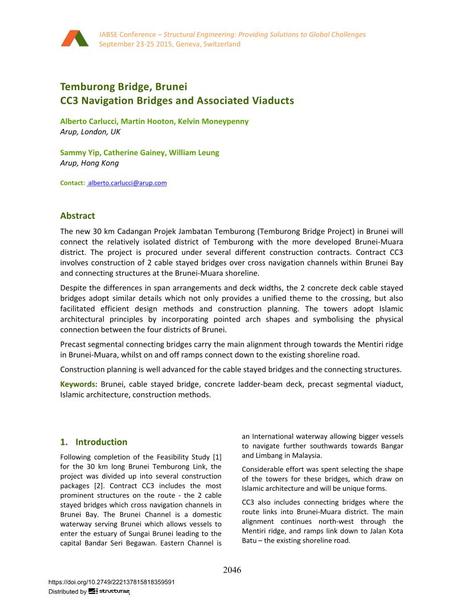Temburong Bridge, Brunei – CC3 Navigation Bridges and Associated Viaducts

|
|
|||||||||||
Bibliographic Details
| Author(s): |
Alberto Carlucci
(Arup, London, UK)
Martin Hooton (Arup, London, UK) Kelvin Moneypenny (Arup, London, UK) Sammy Yip (Arup, Hong Kong) Catherine Gainey (Arup, Hong Kong) William Leung (Arup, Hong Kong) |
||||
|---|---|---|---|---|---|
| Medium: | conference paper | ||||
| Language(s): | English | ||||
| Conference: | IABSE Conference: Structural Engineering: Providing Solutions to Global Challenges, Geneva, Switzerland, September 2015 | ||||
| Published in: | IABSE Conference Geneva 2015 | ||||
|
|||||
| Page(s): | 2046-2053 | ||||
| Total no. of pages: | 8 | ||||
| Year: | 2015 | ||||
| DOI: | 10.2749/222137815818359591 | ||||
| Abstract: |
The new 30 km Cadangan Projek Jambatan Temburong (Temburong Bridge Project) in Brunei will connect the relatively isolated district of Temburong with the more developed Brunei-Muara district. The project is procured under several different construction contracts. Contract CC3 involves construction of 2 cable stayed bridges over cross navigation channels within Brunei Bay and connecting structures at the Brunei-Muara shoreline. Despite the differences in span arrangements and deck widths, the 2 concrete deck cable stayed bridges adopt similar details which not only provides a unified theme to the crossing, but also facilitated efficient design methods and construction planning. The towers adopt Islamic architectural principles by incorporating pointed arch shapes and symbolising the physical connection between the four districts of Brunei. Precast segmental connecting bridges carry the main alignment through towards the Mentiri ridge in Brunei-Muara, whilst on and off ramps connect down to the existing shoreline road. Construction planning is well advanced for the cable stayed bridges and the connecting structures. |
||||
| Keywords: |
construction methods cable stayed bridge Brunei concrete ladder-beam deck precast segmental viaduct Islamic architecture
|
||||
